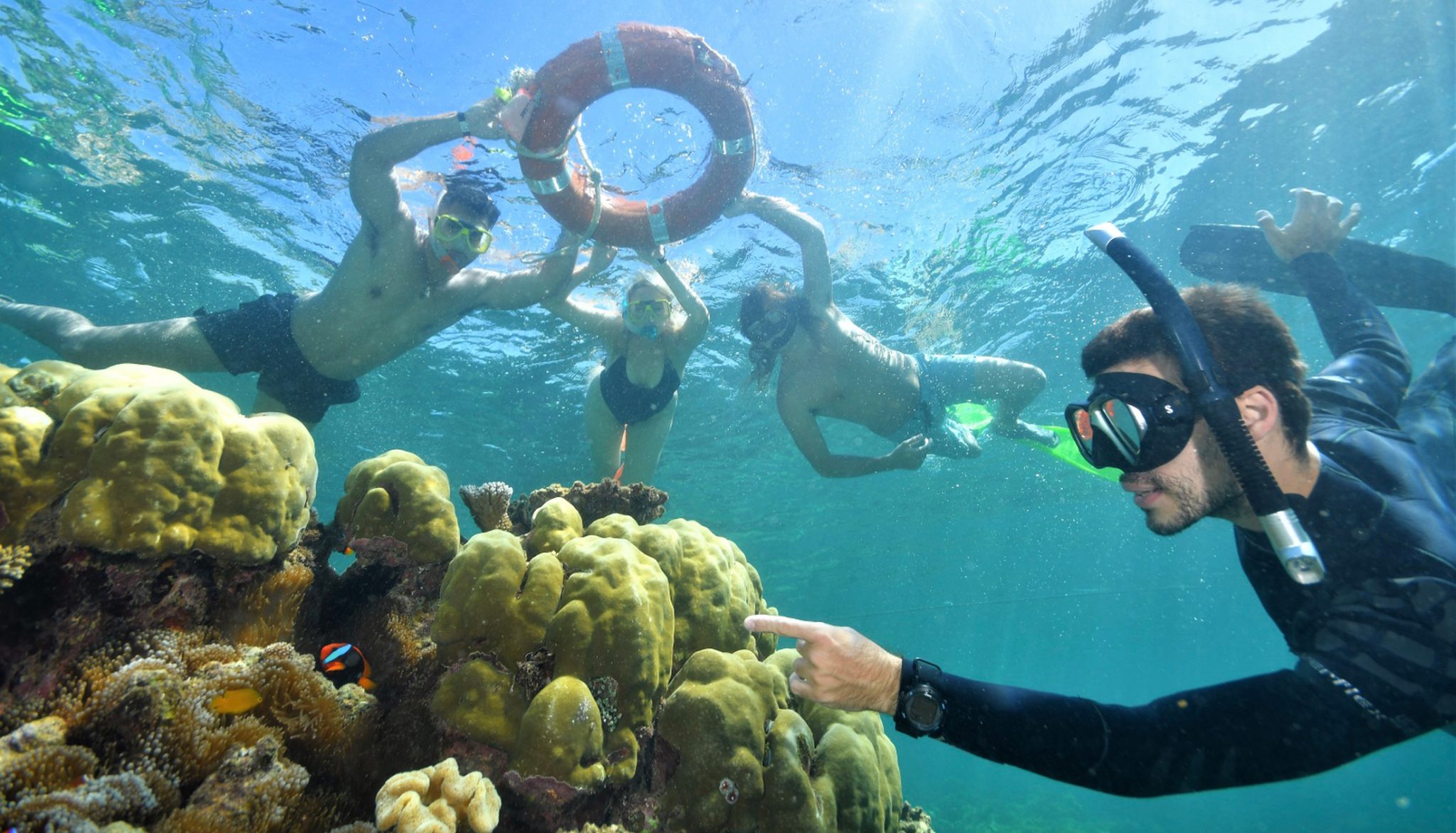Visitors to the Great Barrier Reef are learning about the diversity and complexities of the world’s largest coral reef system from a group of qualified storytellers.
There are 26 Master Reef Guides working on the Great Barrier Reef with 17 of them in Tropical North Queensland. A third cohort is about to undergo training with the Great Barrier Reef Marine Park Authority to become recognised as the world’s leading reef guides, interpreters and storytellers sharing the wonders of the World Heritage Area.
Frankland Islands Reef Cruises Master Reef Guide and marine biologist Alessandra Giannascoli said visitors were surprised at the diversity of coral cover surrounding the islands south of Cairns as they were so close to the mainland.
“There is about 75% coral coverage on the reef around the island which has great diversity,” she said.
“Seagrass grows underwater in the sand making the Frankland Islands a great feeding ground for dugongs and green sea turtles which are regularly seen. The turtles’ nest on the island, manta rays use the surrounding reef as a cleaning station and reef sharks frequent the area.”
Mike Ball Dive Expeditions Master Reef Guide Kiana Saltarelli works on liveaboard vessels that take divers north of Cairns to some of the Great Barrier Reef’s best dive sites for three to seven-night experiences and the most common question they ask is whether the reef is dying.
“We visit Two Towers on Ribbon Reef 10 each year as it is a hot spot for minke whale interactions and after the 2016 and 2017 bleaching events we saw a loss of coral there, but coral regeneration happened at a fast pace. We are now seeing what I deem to be 70% live coral coverage,” she said.
“After two cyclones, Ita in 2014 and Nathan in 2015, the Cod Hole on Ribbon Reef 10 and Pixie Gardens on Ribbon Reef 9 were left with storm damaged areas. Since then, we have witnessed baby corals, in particular, hard corals, cover those areas.”
Quicksilver Connections Master Reef Guide and marine biologist Glen Burns said the reef was full of life, even in the patches of dead coral rubble where closer inspection might reveal a polychaete worm and an encrusted sponge.
“I get asked why the reef’s colours aren’t as vibrant as they are in photographs. Photos tend to show only the corals with the most vibrant colours and are taken with a flash to show up the colour, which gives a skewed perception,” he said.
“The seawater also acts as a blue-green filter for colours. You do see beautiful brightly coloured corals, but the typical colours are yellow, brown, green and blue.”
Ocean Spirit Cruises Master Reef Guide and marine biologist Samantha Gray said the only way to figure out that the Great Barrier Reef was not dead was for people to come and see it for themselves.
“There are multiple ways you can get in close to enjoy the reef – diving, snorkelling, semi-submersibles, and glass-bottom boats – so there is a way for everyone to see the Great Barrier Reef,” she said.
“When you put your head underwater you see this whole other planet open up before your eyes. When people fall in love with what we have here they leave as an ambassador for the Great Barrier Reef and take action by avoiding the use of single-use plastic and trying to reduce their carbon footprint.”
Sunlover Reef Cruises Master Reef Guide and marine biologist Pablo Cogollos said the best part of his role was being able to inspire people about the positive changes that everyone can make in their daily lives.
“We know that the reef is under a lot of pressure, but it is not too late to help her. Every action counts,” he said.
“I watch the new generation of corals growing each day, reminding me how resilient the Great Barrier Reef is, and I love being able to show that to people from all over the world.”
Tourism Tropical North Queensland Chief Executive Officer Pip Close said the tourism industry provided a way for visitors and locals to understand both the challenges and opportunities for the Great Barrier Reef.
“Our industry works in partnership with the science community on projects that demonstrate the reef’s recovery, regeneration and resilience and Master Reef Guides help communicate these messages to their guests,” she said.
Master Reef Guides are recognised as the world’s leading reef guides, interpreters and storytellers sharing the wonders of the Great Barrier Reef World Heritage Area. The Master Reef Guide Program is led by the Great Barrier Reef Marine Park Authority, in partnership with the Association of Marine Park Tourism Operators and Tourism and Events Queensland.
Master Reef Guides in Tropical North Queensland:
- Cairns Dive Centre – Richard Blanch
- Divers Den – Paolo Bonvini
- Frankland Islands Reef Cruises – Alessandra Giannascoli
- Gempearl – Gary Hawkes
- Mike Ball Dive Expeditions – Kiarna Salterelli
- Ocean Safari Cape Tribulation – Brooke Nikora
- Ocean Spirit Cruises – Samantha Gray
- Passions of Paradise – Russell Hosp
- Quicksilver Connections – Glen Burns
- Reef Magic Cruises – Eric Fisher
- Reef Teach – Gareth Phillips
- Sailaway Port Douglas – Louisa Payne
- Seastar Cruises – Laura Ronderos
- Sunlover Reef Cruises – Pablo Cogollos and Luke Smith
- Tusa Dive – Michelle Barry
- Wavelength Cruises – Kasey Barnes
Every person visiting the Great Barrier Reef takes part in its future by paying the $6.50 Environmental Management Charge which is applied directly to the management, research, protection and preservation of the Marine Park.
Ocean Spirit Master Reef Guide Sam Gray talks about her role at Michaelmas Cay. View here.
30 August 2019
Cairns
